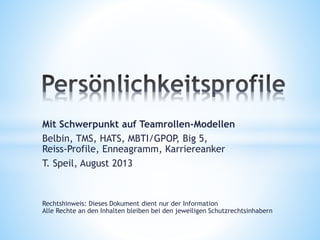
Vergleich_Persönlichkeitsprofile_TSpeil_130829-1.pdf
- 1. Mit Schwerpunkt auf Teamrollen-Modellen Belbin, TMS, HATS, MBTI/GPOP, Big 5, Reiss-Profile, Enneagramm, Karriereanker T. Speil, August 2013 Rechtshinweis: Dieses Dokument dient nur der Information Alle Rechte an den Inhalten bleiben bei den jeweiligen Schutzrechtsinhabern
- 2. • Es gibt eine Vielzahl von Persönlichkeitsmodellen • Einige betrachten nur das Individuum, andere auch Rollen im Team • Dieses Dokument gibt nur einen oberflächlichen, nicht vollständigen Vergleich einiger Modelle • Die Basis der meisten Persönlichkeitsmodelle liegt in amerikanischen Entwicklungen der 1930er Jahre • An strikten Typologien wird oft kritisiert, dass die meisten Menschen in vielen Aspekten eher ausgeglichen sind, als deutlich gegensätz- liche „Pole“ zu haben (Symmetrische Normalverteilung) • Menschen können sich situativ sehr unterschiedlich verhalten, sowohl beruflich als auch privat • Viele Modelle gehen daher von einer individuellen Gewichtung der Aspekte aus, oder von 2 oder 3 besonders stark ausgeprägten (angrenzenden) Rollen, die sich im Lauf des Lebens/Arbeitskon- textes auch ändern können. • Präferenzen sind situativ sinnvoll oder nicht, nicht „absolut“
- 3. • Die Verteilung von Präferenzen kann sichtbar gemacht werden (Lücken/blinde Flecken/Cluster/Rivalität) • Sie bieten einen Ansatz zur Konfliktreduktion und Ver- besserung der Arbeitsverteilung (Zufriedenheit, Effizienz) • Schaffung eines gemeinsamen Verständnisses/Sprache • Gemeinsames Interesse an Verbesserung und regelmäßiger „Messung“/aktivem Austausch schaffen • Abgleich Anforderungen + Präferenzen im Team (Gap) • Aufgaben können nach Erfolgskriterien/hauptsächlich notwendigen Typen untersucht werden • Oft sind nur 2-3 Arbeitsfunktionen für eine bestimmte Aufgabe entscheidend/dominant (Vergleich Pareto-Prinzip)
- 4. • MBTI, GPOP, TMS, Insights basieren auf Weiterentwicklung der Typologie von C. G. Jung • C. G. Jung war ein Schweizer Psychiater (1875-1961), Schüler von S. Freud, Begründer der Analytischen Psychologie • Jung‘sche „Typen“: Fühlen/Denken, Intuition/Sensorisch, jeweils als intro- oder extravertiert • → 8 Typen/Eigenschaften: jeweils Paar aus extra-/introvertiert, praktisch/theoretisch, hart/kooperativ, geplant/spontan • Es gibt deutliche Kritik, dass diese Typen intuitiv/subjektiv gewählt wurden und einer wissenschaftlichen Prüfung nicht standhalten • In der heutigen Psychologie und Wissenschaft spielen die Jungschen „Funktionen“ keine Rolle mehr; sie sind veraltet, können aber übertragen werden
- 5. Lars Lorber (Autor; www.typentest.de) schlägt folgende Interpre- tation vor, die mit dem aktuellen Stand und Modellen wie Big 5 vereinbar ist: • Durch Test oder Selbsteinschätzung die stärkste Eigenschaft finden = Hauptfunktion; Zweitstärkste Eigenschaft = zweite Funktion etc. • Die Reihenfolge der 4 Komponenten kann dann nach dieser Stärke (ähnlich wie Skala bspw. bei Big 5) angeordnet werden oder unterstrichen/hervorgehoben, … • Ambivalenz/“Unentschieden“ könnte auch durch ein „x“ gekennzeichnet werden • Dadurch entstehen eine Vielzahl möglicher, feinerer Kombinationen (Vermeidung fester Schablonen) • Analog anwendbar auf MBTI etc.